|
FAQs about Acroporid Predators and Pests
FAQs on Acroporid Disease:
Acroporid Disease 1, Acroporid Disease 2, Acroporid Disease 3, Acroporid Disease/Pests/Predators
4, Acroporid Health
5, Acroporid Health
6, Acroporid Health
7, Acroporid Hlth.
8, Acroporid
Hlth. 9, Acroporid Hlth. 10,
FAQs on Acroporid Disease by Category:
Environmental (Pollution/Poisoning, Lighting...),
Nutritional, Social (Allelopathy),
Trauma,
Pathogenic (Infectious, Parasitic, Viral)
Predatory/Pest
(see below), Treatments
FAQs on Pests of Acroporids:
Montipora Munching Nudibranchs,
Flatworms,
Red/Black "Bugs"
Acropora Munching Copepods,
Acropora Crabs,
Related Articles: Coral Pests and Disease; pests, predators,
diseases and conditions by Sara Mavinkurve, Acroporids, SPS
Corals,
FAQs on Stony Coral Disease by Type: Brown Jelly Disease, RTN,
|
Crabs, shrimps of various families; even worms... are
not necessarily deleterious. There are scientific papers on the
advantages of many of these commensals, mutualistic species.... keeping
away predators, bringing in food, enhancing circulation.
|
Acro Spots 7/15/19
Bob,
<Eric>
Are you able to see videos on YouTube?
<Sure; was just watching "Hot Ones" there last night>
I can not catch one of these bugs to view under a microscope and I can never
find them in the bucket after dipping the coral. Been trying all day. I got a
very close video of my slimer who lost all polyp extension. Is this an Acro pest
or a pod? Item moves like a Red Bug but is grayish / black.
https://youtu.be/D54AeyaPYzw
<Where is this in the field of view? Bob Fenner>
<Looked again, near the top ... there are two ... from the size, shape, and
movement these do look like Tegastes to me. B>
Re: Acro Spots 7/15/19
I have noticed them on all my Acros. I should definitely treat the tank with
Interceptor right?
<Yes I would; ASAPractical. BobF>
Re: Acro Spots 9/11/19
Bob,
<Eric>
Treated the tank last night with Interceptor. Lost a few hermits but my
large shrimp and crabs made it through.
<... better to treat the stony corals outside the main system to avoid such
crustacean losses>
Unfortunately so did the bugs. I am assuming the next course of action is to do
a larger dose over a longer time period?
<Mmm; no. You DID turn off all mechanical filtration during treatment? The
skimmer, contactor/s, UV...?
I would re/treat ONLY at the standard dose/regimen.>
I did the standard dose over 6 hours. Is it feasible to try and treat one of the
infected pieces in a separate bucket to gauge what dosage will actually work?
<Yes>
I cant catch my shrimp so was trying to do my best to make sure they made it
through okay.
<... again, do you have another established system, container you can/might move
the Acropora to after treatment outside this system? Bob Fenner>
Thanks,
Eric
Re: Acro Spots
Bob,
<Eric>
So it seems like over the 48 hours after the interceptor treatment the bug
population is down substantially. In fact I only see them left on one Acro. I am
also not sure if what I am seeing are just small pods as they look a lot smaller
and move a lot faster than the other ones.
<Okay>
Unfortunately I do not have an extra tank that can handle Acros. What I am going
to do is remove the few pieces and the 1 that has active bugs and dip outside
the tank.
<All right...>
I will then monitor from there. I can say though that my DKH dropped from 9 to
7.8 after the treatment so I am assuming the lower value was caused by the
corals starting to grow again
<... or other effect.>
which shows the interceptor definitely had some impact.
<Yeah mate; it's a selective (more/less) poison. B>
Montipora Eating Nudibranchs
6/1/15
Hi Bob,
<Hey Robin>
For a couple months now I' be having problems with my Montipora corals.
At first I thought it was something environmental or bacterial as I began to see
what looked like bleached, degrading coral flesh on the edges of my Montis. I
religiously dip any frag that goes into my tank so a parasite had not even
crossed my mind.
<Mmm; some dips, procedures are better than others (by far); and none are 100%
effective over time...>
Today I was getting ready to do my usual tank maintenance on the 120g reef and
started by blowing this fuzzy white stuff off the Montis with a turkey baster.
Suddenly as the stuff was floating away I noticed some of it was wiggling and my
heart sank. They were Monti eating Nudibranchs.
<Arggghhhh! VERY hard to eliminate... requires utmost patience in isolating ALL
colonies, systematically dipping.... perhaps breaking off new culture pieces and
abandoning larger in big facilities... Do you know Morgan Lidster of Inland
Aquatics? I'd have you chat w/ him. Have bcc'd him here>
Everything I've read about them here and elsewhere does not bode well. I have
some large encrusting colonies on huge rocks that would be very, very difficult
to dip and even harder to quarantine. What should I do???
<Move the Montipora/s, VERY carefully observe them; dip enroute, scrubbing or
breaking off all suspicious areas... Place in NEW, known clean systems...
utilize Labrid eaters there.>
Thanks,
Robin
<Oh, do see WWM re what we've accumulated re:
http://www.wetwebmedia.com/MontiNudiF.htm
Bob Fenner>
|
Dear Bob
About 4 months ago I bought a Large
Yellow Acropora frag inside the frag there where two small crabs
( Dark reddish brown with white eyes and about 6mm across the
carapace ) the coral seems fine but I have noticed that the
polyps don't come out all the time when the crabs are
feeding.
My worry is, are they feeding on the
polyps? The reason I ask is I just got a blue Acropora and one
of the crabs was on it. The next day it was back on the yellow
one but the blue one looks patchy.
Mmmm, well, there is documented proof of some
of the commensal crabs being a bit more than just space hitchhikers.
That is, they are known to nibble at living tissue of their stony coral
hosts. But on the positive side, these crabs, particularly the
better-studied Trapeziids, are known to protect their living coral homes
from predators and sediment accumulation. It's not lost on me that the
relationship twixt these two is so intimate that the crab species aren't
found elsewhere and even if their symbiotic relationship trends
toward the decapods being a bit parasitic, all the instances
I've encountered in the wild have shown both parties to be in
good health. I suspect that as long as conditions are propitious
for them both (a bit of food provided for the crabs daily) that
your Acroporas aren't in imminent danger. Reef coral studies
have shown that the few polyps lost are a well-worth trade-off
for protection and house cleaning services. I would leave these
two together.
|
Fish living inside Acropora 1/26/12
Hello Gang.
<Vince>
I recently purchased an Acropora about 5" in diameter. Inside the
coral there is a crab (your typical smooth shell crab that usually
comes with it). I also noticed there is a small purple fish with black
eyes hiding inside it. The fish is flat body about 3/4" long. Is
the fish harmful to the Acropora?
<Mmm, not likely... from the color, desc., is likely a
Caracanthid:
http://www.wetwebmedia.com/caracanthidae.htm
Should I remove it? I don't want to remove and risk injuring the
fish if it is harmless.
<I wouldn't remove... an interesting addition... is venomous if
you do intend to handle>
Thanks in advance.
Kind regards,
Vincent Cheung
<Welcome! Bob Fenner>
Re: Fish living inside Acropora 1/26/12
Hello Bob.
<Big V>
Thanks for the quick response.
<Welcome>
Yes the fish does resemble the Caracanthid now that you pointed me in
the right direction. I am surprised it is more related to the lionfish
then a goby.
<Neat eh?>
That was a lucky purchase to have a fish as well as a crab with the
Acropora. Thanks for the heads up on the venomous part.
<Who said heads up?! Huh, I'll take some of that!>
Regards,
Vincent
<And you, BobF>
|
Montipora Eating Crab 1/23/12
Dear Crew,
<Joe>
I hope that you are doing well!
<And you>
I just wanted to request a quick ID today if at all possible. One
of my Montipora digitatas was bleaching a bit at the tips and
today, I found this little guy attached! So sorry, about the
picture quality but these were the best shots out of about 25.
It's definitely a crab, brownish/red in color, hairy arms as
well as barely visible pinchers (sorry, no microscope). This is
the only one that I've witnessed so far and it seemed to
arrive when the Montipora was added to the tank. I'm almost
certain that it was a hitchhiker. It was accidentally killed upon
extraction from the coral.
<Mmm>
Should I be on the lookout for more? My hunch is that it is a
loner.
Lastly, in your opinion, should I break off the dead section of
coral, or just leave as is?
<Well, hard to say, make that determine, if this little
Decapod is much of a real or potential risk to your Montipora...
the group is generally omnivorous... but there are many crabs
(e.g. Trapeziids) that are found in close association w/
Scleractinians, Alcyonaceans, Pennatulaceans... and more
Cnidaria, that are more commensal than not. Some known to keep
off other predators, improve circulation...>
Thank you!!
Joe
<Up to you to remove or no of course. Bob Fenner>
|
|
 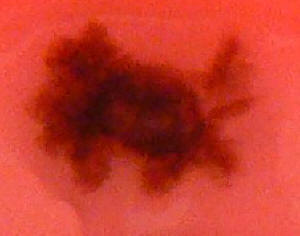
|
urgent help needed, Acropora pest 10/12/11
Hello, how are you?
<Fine, thank you>
I stumbled across your site on a search for some urgent answers in
regards to one of my gorgeous Acropora corals.
Today I was looking closer then usual when I noticed a black spot
starting on the back of it ( this is a dark yellow Acro) then upon
closer inspection I realised there is 3 holes(like something is living
in it) I then noticed almost invisible long string type things coming
out of the hole( I wish I had a camera to take a picture)
<Me too>
These things quickly retracted every time I tried to catch them with my
tweezers.
My questions are;
What is this thing?
<Likely Hydrozoan/Hydropolyps>
And how do I get rid of it?
<Read here: http://wetwebmedia.com/hyzoancompfaq.htm
I read I can put super glue over the holes and what ever's living
on there will die. Is this true?
<Likely so>
Thanks so much in advance ! Hopefully we can save my Acro!
<If it doesn't show signs of being stung badly... not such a
panic... >
Melanie
<Cheers, Bob Fenner>
|
Acro Crab? Possible Trapeziid or Juvenile of
Undetermined Family -- 3/28/10
<Hi Mike, Lynn here today.>
Just found this little crab on a new shipment I just
received.
<Neat! What kind of shipment -- coral (Acropora, Pocillopora,
Stylophora, etc.?), rock, or something else? Where was the
shipment from? What's the size of the crab (carapace
width)?>
Hoping you can confirm whether of not it's an Acro crab?
<That's a tall order! Did it hitchhike in on an Acropora
colony? It could be a coral crab, or it could simply be a
juvenile of some other variety. It has the same large eyes,
roughly triangular carapace, and claw length/shape that you see
in many Trapeziid crabs (family Trapeziidae -- aka 'coral
crabs' or 'coral guard crabs'), but the color/pattern
of the carapace is atypical. That is, it doesn't fit with
what photos I've seen of Trapeziid crabs. The problem is that
there are an awful lot of crab species out there, not all of
which are available as photos on the web or in my research books.
What you have may be a coral crab that in its juvenile phase has
a completely different, more cryptic coloration, than its adult
counterpart. This is not at all unusual in crabs, or other
animals for that matter. Unfortunately, I haven't been able
to find any photos of juvenile Trapeziid crabs for comparison.
Again, there's the distinct possibility that this little crab
could simply be a juvenile from any number of other families.
Juvenile crabs typically have the same large eyes that you see in
Trapeziids. The bottom line here is that unfortunately, all I can
offer are a whole lot of maybes and no concrete answers. Time and
behavior will tell with this little fellow. I can tell you one
thing though. Trapeziids are generally found in the Pacific,
either the Indo-West or tropical Eastern regions. If this little
crab came in on a shipment from say Florida or the Caribbean,
chances are it's not a Trapeziid. Please see the following
link for an example of a juvenile Callinectes sapidus, aka
'blue crab' (see last photo). This is definitely not what
you have (and not a variety of coral crab), but you can see the
similarities:
http://www.serc.si.edu/education/resources/bluecrab/lifecycle.aspx
Here are some examples of coral crabs, along with more info (see
bottom of page):
http://www.chucksaddiction.com/hitchcrabs.html
More info at WWM:
http://www.wetwebmedia.com/Arthropoda/CrustaceanPIX/SWCrabs/Crab%20IDs/SWCrabs3.htm
>
And good/bad?
<Time will tell. This could be a relatively harmless coral
crab, or something else entirely. Since I can't confirm
either way, I'll offer the standard crab warning. That is,
crabs are omnivorous opportunists and scavengers that, if hungry
enough, can and will eat pretty much anything they can grab with
their claws. You have the choice of keeping, observing, and
removing if/when the crab becomes a problem or playing it safe
and putting it elsewhere until you have a better idea what it is
and how much risk it poses to other livestock. Either way, do be
sure to keep it well-fed with meaty scraps of marine origin
(shrimp, clam, squid, fish, etc.) or perhaps sinking
pellets.>
Attached a pic for ID.
<Thanks, he/she certainly appears to be an itty-bitty
thing!>
Thanks!!
<You're welcome!>
Mike
<Take care, LynnZ>
Re: Acro Crab? Possible Trapeziid or Juvenile of
Undetermined Family -- 3/28/10
Lynn,
<Hi Mike>
Thank you for the response.
<You're very welcome.>
He was attached to a "purple monster Acro" from either
the Solomon Islands or Fiji, my supplier only specified vaguely
where all our corals came from, one or the other.
<Thanks, that helps. I just wish that it was enough to be able
to offer you a positive ID! As it stands right now, I'm not
sure what type of crab this is. As was evident in the photo of
the blue crab (see link in previous response), appearance can
change significantly from juvenile to adult. We should know more
as this little fellow matures. Honestly, it could be one of many
different genera (not just in the family Trapeziidae) that are
associated with Acroporids. It could also be an accidental
hitchhiker; that is, not a coral crab at all. Perhaps it was
ousted from its normal habitat during collection and simply took
refuge within the coral's branches.>
I've attached a not so macro pic for a naked eye view as
well. He is tiny, maybe 3-4 mm.
<Yep, that is one small crab!>
Thanks again!
<It was a pleasure! I'm just sorry that I couldn't
give you a more definitive answer.>
Mike
<Take care, LynnZ>
|
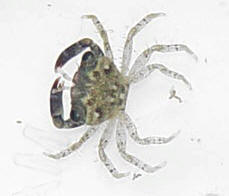 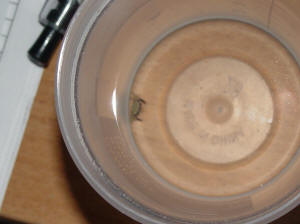 |
|
Cyanobacteria 5/25/09
Dear Bob, Mr. Calfo,
<Hello, Scott V. with you today.>
I have big problem with Cyanobacteria which has spread out on my
Acropora on peaks, I am trying to blow them with turkey baster
everyday, but it seems it will not want to leave. When I am
blowing Acropora's peaks-end also some part of tissue is
damaged and coral is losing Zooxanthellae. I have tried to bath
coral in tropic Marin pro cure but Cyano is retrieving back.
<This will not do it.>
Cyano was caused by my mistake that I have put china MH bulbs
instead good ones. Please help!
<Well, in the end there are other fueling factors behind the
BGA besides the light, see:
http://www.wetwebmedia.com/bluegralgae.htm
There are other factors at play. As for your corals, you will
need to figure out what is causing the BGA to be so competitive.
Until then keep blowing off what you can.>
Re: Cyanobacteria 5/26/09
Ok, thank you so much, I will keep trying.
<Welcome, this battle can be won! This is a mild case, you
have caught it early. Scott V.>
|
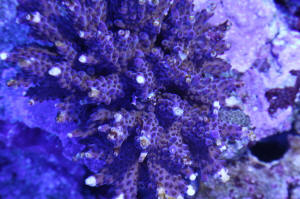 |
|
Pistol Shrimp Hitchhiker: Coral Commensal --
Coralliocaris spp. 5/24/09
Hi Guys, Janet here.
<Hi Janet, Lynn here today>
I bought a colony of Acropora last week and have found 2
hitchhikers in it.
<Neat!>
I know that Acropora generally will come with an Acro crab, but
these little guys are shrimps.
<They sure are. They're small coral commensals, in the
genus Coralliocaris (only around 8-9 species recognized at this
time). Unfortunately, I was unable to find photos of each species
for comparison, but I did find one that looks similar enough to
be a definite possibility. This species, Coralliocaris graminea,
varies in color, but has the same thin, longitudinal lines on the
body, as well as orange-ish tipped legs and claws. Please see the
following links for comparison/more info:
http://tolweb.org/onlinecontributors/app?page=ViewImageData&service=external&sp=26879
http://www.vanaqua.org/aquanews/field/images/yaqara.htm
http://www.seadb.univpm.it/en_Green-Acropora-commensal-shrimp-Coralliocaris-graminea_587.htm
Also, if you happen to have Helmut Debelius' book, Crustacea
Guide Of The World (2nd edition), see page 189. Reportedly, this
Acropora commensal reaches about 1cm in length and is indigenous
to the Indo-West Pacific region.>
They were inside the Acropora colony, and I managed to
"spook" them out and get them into a container for a
picture and to make sure they were reef safe etc. I am attaching
a picture of one of the two.
<Super, thanks>
The other one has no claws, but is identical other than that. The
2 of them must have had a tussle and one ended up with no claws
out of the deal?
<Perhaps yes, or it could have been due to rough
transit/handling when collected, shipped, etc.>
I currently have them in a 10g emergency tank. Do these guys eat
Acro?
<Not according to what I've read. They're commensals
that likely have little negative impact on the colony.>
It is even a pistol shrimp?
<No. Although these shrimps do use their claws to make
clicking/snapping noises, they're not actually what we
consider pistol shrimps (family Alpheidae). They belong to
another family: Palaemonidae, subfamily Pontoniidae. This group
of shrimps doesn't have the same formidable snapping ability
of the Alpheids. Also of note is that the claws of Coralliocaris
species are matched in size, whereas those of the Alpheids are
markedly different. For more in-depth info on snapping claws,
please see this pdf file:
http://decapoda.nhm.org/pdfs/27238/27238.pdf . It's probably
more than you ever wanted to know, but it's
interesting!>
The Acro colony has had some die off which occurred after getting
it home a few days later.
<Can happen sometimes>
I have another smaller colony of Acropora, but this piece is
fine.
<Excellent>
Because of the die off I started taking a look at the colony to
see if I could determine what may be happening to it. This is
when I noticed these little guys. I actually managed to nab both
of them in my 75 gallon tank without losing them and then moved
them to the 10 gallon tank. As you can see by the picture of the
shrimp in my hand, they are very tiny.
<Yep, that's typical for these guys. The genus as a whole
generally ranges in size from 1-2cm.>
This is a picture of the larger one too. Can you provide any
information as to what they are, and if they are reef safe or
not. Do they prey on Acropora only or any Sps coral?
<I haven't come across anything indicating that
they're parasitic, or harmful to corals at all, so you should
be okay.>
Thanks, Janet
<You're very welcome. Take care, LynnZ>
|
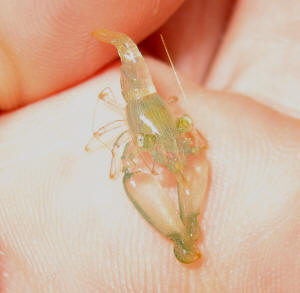
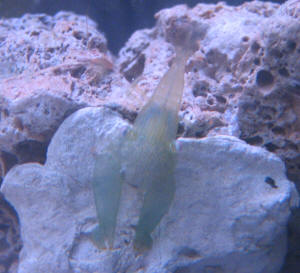 |
|
Re: Pistol Shrimp Hitchhiker: Coral
Commensal -- Coralliocaris spp. 5/25/09
<Hi Janet>
Well, thanks for the great info on my little shrimps.
<You're very welcome.>
I have left them in the 10 gallon as I don't think they will
keep up with my 75 gallon crew of fish and crustaceans. I have a
maroon clown, with a rose bubble anemone and she is rather a
misery and huge! I love her though and would not part with
her.
<I can sure understand. I used to have a tomato clown with all
the charm of a rabid wolverine but I loved her anyway.>
Also a Yellow Tang, tiny Hippo Tang, 1 Coral Perch and 2 Chromis,
2 blood shrimp, 1 coral banded,
<Watch out for this guy. They've been known to kill other
shrimps, hermits and the like.>
..and 1 cleaner shrimp as well as the regular snails, hermits,
serpent stars (also finding baby serpent stars by the dozen, and
also moving them too), and last, 2 sand sifting stars.
<These are neat creatures, but don't do well in most
systems. Unfortunately, they wipe out the sandbed fauna then
starve.>
I also have a Yellow Watchman Goby, and he is paired with a tiger
pistol shrimp.
<Love this combination>
That's another reason why I questioned if these 2 were in
fact pistol shrimps. I did notice that the little guys' claws
were the same size each, but had what looks like the little
snapper.
<Yep, the claws look just like a pistol shrimp's.>
I don't think that whoever shipped this colony of Acropora
would have known they were in there do you think?
<I seriously doubt it. Those shrimps are small, cryptically
colored, and know how to hide within the coral's
branches.>
Sadly there has been more die off and I don't see the
Acropora crab in there anymore.
<Oh? I didn't realize you had a crab hitchhiker as well -
neat.>
Do the Acropora crabs leave the colony if it's not doing
well, or do they die?
<I imagine they stick with the coral until it's pretty
well dead, then move on to another.>
This particular piece was large and nice. It may have been in
rough shape when I bought it, hence the "sale"
price.
<Yep, that's usually a clue that's something's not
quite right.>
I may be able to salvage some by fragging it. Does this make
sense
<Yes, that is if you can't return it for a refund/credit.
Be sure to look over the "Coral Pests and Disease" page
(link below) so you can get a better idea of what's going on
with the coral. If it's rapidly turning white/losing tissue,
it could be RTN (rapid tissue necrosis) or 'white band
disease'. If that's the case, you'll want to remove
the coral and frag it immediately. In the case of pests, follow
the instructions given for each:
http://www.wetwebmedia.com/corldisart.html
More info on Acropora selection, issues, here:
http://www.wetwebmedia.com/acropt3.htm
Good site with a key for diagnosing coral disease:
http://ourworld.compuserve.com/homepages/mccarty_and_peters/coral/Stonyq0.htm
>
..and how should I frag it?
<If it's RTN/WBD, break off healthy pieces well away from
any white areas.>
I have a 30 gallon tall seahorse tank too, but there is also a
blue pistol shrimp in with them. What is your suggestion about
where I could keep these guys?
<Optimally, I'd recommend keeping them with an Acropora
colony. I wasn't able to find any information regarding the
exact diet of these shrimps. They may be like some commensal
crabs in that they feed, at least partially, on the mucus
produced by the coral. I honestly just don't know.>
What about feeding?
<I would try offering a variety of foods and see what they
like, including small meaty bits of marine origin (Mysis shrimp,
silverside, etc), along with some good quality sinking pellets or
even flake food.>
I can just leave them in the 10 gallon as there is nothing
detrimental to them in there. If they are fine in the tank I
don't want to part with them. Did I end up with a rare
find!!???
<Well, it's not something you see every day, but I have
run across other reports of hobbyists finding these shrimps
within their corals. I do believe however, that this is the first
time we've ID'd them here at WWM!>
If the Acropora doesn't make it should I give the skeleton to
them for cover?
<Sure, as long as there's no lingering disease or pests
that might be introduced to any other resident corals.>
It would be a shame to have the entire colony die, I hope to
salvage what I can.
<I sure hope you can too.>
You see when I got it home from the store, I obviously dripped it
and then added it to the large tank. Sometimes I take a turkey
baster and clean the rock of detritus and such. When I did this
around that colony, a lot of the "flesh" pretty much
just blew away exposing the white skeleton.
<Ouch, not good>
I'd only had it a few days. I have a T5 HO lighting system.
Are these sufficient for this type of coral,
<Given enough bulbs and good placement, sure.>
..because I don't want to buy something that won't
survive in my tank, until I can change the lighting system if
required.
<Good thinking. For more information on SPS system
requirements, please see this link:
http://www.wetwebmedia.com/acropt3.htm >
This is a great site! And thank you so much for the extremely
quick response.
Thanks LynnZ
<You're very welcome. It's always nice to chat with
fellow hobbyists about such neat little creatures! Take care,
LynnZ>
|
Acropora Damage 'Healing -- 04/15/08 Last
night, I found a little crab in my new colony of yellow Acropora. After
the excitement, I found out that this crab, what I know now is a hairy
crab, is bad and eats Acropora tissue and polyps. <<A
generalization 'and not 'always' the case>>
After seeing the damage the little crab did,
<<Ah'¦>> I removed him and made him a snack for my
peacock mantis shrimp. <<Neat>> I know it was not an Acro
crab because it was not white; it was brown and furry with white eyes.
<<Again, not always the case... I have a 'brown and
furry' crab living among one of my Acropora colonies that does no
lasting damage>> Now that he is distinguished,
<<'¦?>> I looked at the colony again and saw the
damage. Patches at the base of the branches had been damaged which
leads me to my main question. Will these patches heal on their own or
should I do something? <<If water quality is good the coral
should heal just fine>> All of the branches are only damaged at
the base, with one branch a little higher up in a patch. The colony
still has great color and polyps out nicely where not damaged. Is there
anything special I can give it to recover faster? <<Just a
healthy environment>> I feel Cyclop-eeze and reef Roids to all my
Acros. No other Arco's seem to have the parasite either. Any advice
would be helpful to ease my worry away from this damage. Thanks.
<<Any intervention from you will likely do more harm than good at
this stage. Keep an eye on things and if problems/secondary infection
do set in you may be able to frag away the malaffected portions, but I
think it likely the coral will be fine as is. Regards,
EricR>>
|
Tiny White Crab on Montipora capricornis: Gall crab -
4/8/08 Hey all. <Hi Andy> I have a Montipora
capricornis on which I found a tiny white crab (I think). When I
noticed it this morning, I thought it was simply a piece of
debris hanging off the coral, but tonight with the lights out and
a focused flashlight I was able to see that it was in fact some
type of animal. I was able to suck it off with a turkey baster.
It is very tiny, so without a magnifying glass I can't make
out its features very well, but it does have at least 4 legs on
each side. <Thanks, that's an important bit to know when
identifying crabs!> The best way I can describe it is to tell
you it looks like a white deer tick. <Oh man, do I ever
despise ticks! They're creepy little bloodsuckers!> I have
attached pictures--I hope you can make it out. <Unfortunately,
I can't see enough to differentiate between the two crab
families I have in mind. However, I'm hoping that the photo
links I'll list below will help you determine which one it
really is.> I searched around on WWM to see if anything popped
up on this subject that might give me an ID, but I came up empty
handed. I note that the flesh of the coral at which this crab was
attached all day is totally undamaged, so I'm thinking (and
hoping) that it is not a threat <Not likely, no. Most are
small commensals.> (although I disposed of the crab anyway).
However, there is a tiny, round hole in the structure of the
coral that is under the place this crab was attached and that
looks like it has been there a while (see pic--maybe the crab was
living in this hole?). <Very likely, yes.> Any thoughts on
what this crab might be? <It looks like something either in
the family Cryptochiridae (coral pit/gall crabs -- many genera)
or the family Xanthidae (genus Cymo - gall crabs). I've never
heard of these crabs inhabiting Montipora corals before, but
considering how little I really know and how much I still need to
learn about them, that doesn't mean a whole lot! One thing
that's going to help that I can't see in the photos
relates to the claws. If those on your crab were easily seen and
fairly robust, possibly dark tipped, then it's likely a Cymo
sp (Xanthid). If, however, your crab had barely noticeable,
slender claws, then it's likely a Cryptochirid. The crabs in
this last family look more like ticks to me, but take a look and
see what you think (the first two are Cryptochirids):
Hapalocarcinus:
http://cookislands.bishopmuseum.org/species.asp?id=7372
Cryptochirus:
http://cookislands.bishopmuseum.org/species.asp?id=7200 Cymo:
http://decapoda.free.fr/illustration.php?n=3&sp=212 > As
always, thanks for your help/time. Andy <You're most
welcome. Take care, -Lynn>
Re: Tiny White Crab on Montipora capricornis:
Gall crab - 4/8/08 Lynn, <Hi Andy> Thank you for the
response. <You're most welcome.> Hmmm, hard to tell.
The claws definitely were NOT noticeable. In fact, I couldn't
see them at all--the only things I could see were the 4 legs on
each side. It resembles the Cryptochirid, but doesn't look
like an exact match. <It may be something else within the
Cryptochiridae family. Unfortunately, those were the only two
online examples I could find of the different genera within that
family. Depending on where you look, there are anywhere between 6
to 20 different genera and beyond that, a whole slew of species
so there are lots of possibilities.> I'm just glad it
likely was not harmful to the coral. <Me too!> The marine
world is a strange and fascinating one. <It is indeed! Take
care, -Lynn>
|
|
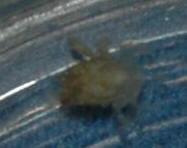 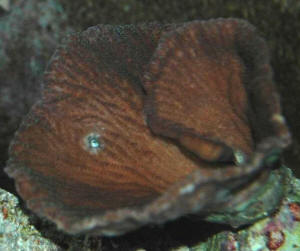
|
| Acropora animal question 9/20/05 <Hi,
Adam J responding to you this evening> I recently bought an
Acropora sp. at one of my LFS. I placed in my tank and
found a small brown looking "bear" on the coral. <Even
though your attached picture was a bit blurry you did a wonderful
job at capturing the animal. It appears to be a common Acropora
Crab, though identifying the exact species is much more difficult,
but more than likely it is harmless.> Is this safe
to leave on the coral or should I try to remove it? <I would not
remove it yet, though I would closely monitor it. Most
Acropora crabs are commensal, feeding off of the waist of the host
coral. Furthermore they usually don't get very big. (Dime sized
is the biggest I have observed) However a few have been known to
pick off/feed on the polyps, so I would still keep an eye on him.
'If you are in doubt take him out.' By that I mean, if his
behavior becomes suspicious (i.e. visible damage to polyps) I would
remove the crab at earliest convenience.> I'm
including a picture of the animal; not the best quality picture.
<The picture was fine, glad to have helped, Adam J> |
|
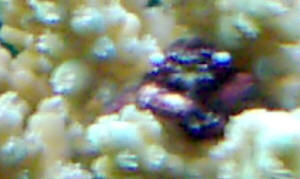
|
Acro Mower Hi Bob <<Good morning, Lorenzo here filling
in for the rest of the crew, off at MACNA in Texas.>> Yesterday
morning I noticed that one of my stag horns had an eaten path carved in
it. Something had sucked the polyps right off. <<Yikes!>>
I'm looking in the tank to see what could have done this. I found a
weird snail with a long trunk not far from where the stag is. Do you
know of any snails that eat SPS? <<Definitely, but not very
common.>> What else should I be looking for? <<There are a
number of animals that will do this, including snails, Nudibranchs, and
sea-spiders (quite rare, but sometimes seen, and does exactly that). At
least if it's a tight, "path" you can probably rule out
your fish. You may need to observe at night, with a red or blue
flashlight to uncover your killer... Good luck! -Zo>>
|
|

